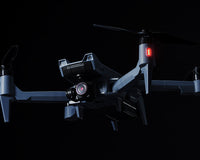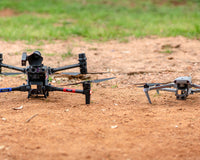If you've been apprehensive about getting into First-Person-View (FPV) flying, DJI has you covered with their newest addition - DJI Avata.
FPV flying is simply exhilarating, and everyone deserves to experience it. It's probably the closest you'd ever get to viewing the world like Iron Man, soaring through the skies - and in 4K, too!
DJI Avata is pretty popular among hobbyists, but it has the potential to be an asset to public safety organizations.
How so, you wonder? Let's break it down.

How can DJI Avata be used in public safety?
A lot goes into traditional FPV flying, including tuning and subsequent modifications. Consequently, many may find the entire process of getting acclimated to FPV flying quite intimidating.
However, with DJI Avata, this no longer has to be the case as it makes the FPV flying experience hassle-free. It's so easy to fly that anyone at any experience level can get it up and running in no time.
While Avata is primarily a slow cinematic flying drone, it includes some impressive features.
1. Great design and build quality
DJI Avata is incredibly compact and light, coming in at a weight of approximately 0.9 lbs. That lightweight nature makes way for its durability. Its sturdy build ensures you enjoy an anxiety-free FPV flight experience.
Flight mishaps are quite the norm when flying FPV drones. They are not normally the easiest to fly, especially in Manual Mode. It takes some practice... and probably a few crashes.
Related Article: How to Create a Law Enforcement Drone Program in 8 Steps
Avata's durable design ensures that, in most cases, your drone will live to fly another day. If you've flown a search-and-rescue mission, then you probably know that nearly any obstacle can ruin everything.
Avata, however, is incredibly resilient under these circumstances. The Cinewhoop-style drone features a ducted design that encloses its four motors. That design protects the Avata's propellers, allowing it to bounce back and resume its flight after encountering an object on its path.
2. Flight time
With its 2420 mAh battery, DJI Avata has a flight time of about 18 minutes under ideal conditions.
3. Flight maneuverability
Avata uses the DJI FPV Motion Controller, which creates room for an intuitive and flexible flight experience, allows you to control your drone as you grip it, bolt forward, and navigate corners with the turn of your wrist.
The main thing to know about the motion controller is that it only works when Manual Mode is off.
Now, during an emergency situation involving fire, due to its maneuverability, Avata may come through as an extra set of eyes to safeguard your team or personnel and for better decision-making that speeds up the rescue operations.
As mentioned, it bounces back from a lot of obstacles, so you can cut through tight spaces.
Intuitive flying goes hand-in-hand with a high-resolution live feed for the team on the ground that's backed up by a quality camera system. So, is the imaging system good enough for your aerial operations?
4. Advanced camera system
Avata's great camera quality is a major selling point.
The drone can fly up to 60 MPH in Manual Mode, and still capture amazing footage. A single-axis mechanical gimbal with a tilt range of -95° to 75° stabilizes the camera.
It features a 1/1.7-inch CMOS, 48-effective-MP sensor with a 155˚ field of view (FOV). The super-wide FOV aims to replicate your normal vision for a super-immersive visual experience while using the DJI Goggles 2 or DJI FPV Goggles V2 with 4K video clarity at up to 60fps.
You can switch the camera settings from the menu on the former to 2.7K at up to 100fps, whereas you can obtain the same level of clarity with the V2 goggles at 120fps. The drone, itself, records videos at a maximum bitrate of 150 Mbps.
Additionally, you can adjust color-mode settings, such as standard and D-Cinelike, to obtain your desired visual quality.
DJI Avata also integrates RockSteady 2.0 EIS to do away with real-time camera shake that distorts the picture and video quality. And, a feature known as HorizonSteady ensures the footage always meets your standards.
All the stills and footage can be accommodated in its 20 GB internal storage, but there's still more room for an SD card with a slot in the rear left propeller duct.
Its high imaging abilities make it the perfect FPV candidate for aerial patrols in confined indoor and outdoor public spaces.
So, what about the transmission system?
5. Improved transmission system
The reliability of the transmission range is usually dependent on how far you fly, and the types of obstacles you'll fly over.
The airframe features O3+ video transmission, which has two transmission modes:
- Low latency
- High quality
The low-latency option will provide your goggles with a high frame rate and significantly reduce video lag.
6. Smart features
DJI Avata features three intelligent flight modes:
- Normal model- suitable for amateur or intermediate UAS pilots.
- Sport mode- ideal for intermediate or professional UAS pilots.
-
Manual model- suitable for experienced FPV UAS pilots.
Avata also includes a feature called Turtle Mode, which flips the drone back whenever it lands upside down.
It has two sensors on its lower side to facilitate its downward obstacle sensing system, making it easier to fly in low altitude and enclosed spaces.
Avata's Return to Home enables it to fly right back to you in the event of signal loss or a low battery. However, the drawback of this is that it could lead to flight mishaps since it lacks the 360° obstacle avoidance system.
DJI tries to minimize these occurrences by providing an emergency pause button, which acts like a kill switch of sorts. That may come in handy when you spot obstacles, and it's too late to make a turn.
Possible drawbacks
Every drone comes with some drawbacks, and Avata isn't immune.
First, it's not overly quiet. If you need to be inconspicuous, the noise coming from the drone may blow your cover.
Next, it requires practice. We did mention that it's easy to use... to a certain degree. As with any drone, you'll need to get familiar with Avata. You'll also need to practice, because FPV is a whole different experience from your standard flight.
If you do get DJI Goggles 2, there's an intelligent application included called DJI Virtual Flight, which provides you with an immersive FPV experience via a simulation. That will allow you to practice without ruining your investment, which is always a plus.
Finally, we'll go back to the battery life ... 18 minutes in ideal conditions isn't that long. If you need to complete a longer mission, then Avata probably isn't for you.
Should You Invest in DJI Avata?
Since a large quantity of our customer base resides in the public safety space, we can tell you with certainty that DJI Avata is a hot item within the industry.
If you've been on the fence about getting into FPV flying, Avata is, perhaps, the easiest and most efficient route to take, especially if you're looking to fly indoors.
Avata stands to benefit public safety missions in so many ways, including providing information in real-time, which gives your team a tactical advantage that improves how you can approach a dangerous situation.
Packages for Avata are as follows:
Additionally, we recommend that you get one with a Care Refresh package. As much as it's durable, the Cinewhoop-style drones are known to crash; you never know when you'll need a replacement fast.
If you're still not sure whether or not DJI Avata is right for your public safety program, we're here to help. Our expert team of UAS pilots, most of which used drones for public safety missions, are here to help you make the right choice.
We can give you training, support, and even some pro tips for certain situations.
Connect with us to get the right drone platform for your organization, or just open the chat box to get stated.










